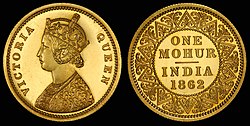
Back موهر Arabic মোহৰ Assamese Moqur Azerbaijani Mohur German Mohur Spanish Mohur French Mohur Kurdish Mohuras Lithuanian Mohur Malay Мухр Russian
The Mohur is a gold coin that was formerly minted by several governments, including British India and some of the princely states which existed alongside it, the Mughal Empire, Maratha Empire, Kingdom of Nepal, and Persia (chiefly Afghanistan). It was usually equivalent in value to fifteen silver rupees. It was last minted in British India in 1918, but some princely states continued to issue the coins until their accession to India after 1947. Similar coins were also issued by the British authorities in denominations of 2⁄3 mohur (10 rupees), 1⁄3 mohur (5 rupees) and the double mohur (30 rupees), and some of the princely states issued half-mohur coins (equal to 7 rupees and 8 anna).
The mohur coin was first introduced by Sher Shah Suri during his rule in India between 1540 and 1545 and was then a gold coin weighing 169 grains (10.95 grams). He also introduced copper coins called dam and silver coins called rupiya that weighed 178 grains (11.53 grams).[3] Later on, the Mughal emperors standardized this coinage of tri-metallism across the sub-continent in order to consolidate the monetary system.
- ^ Cuhaj, George S., ed. (2009b). Standard Catalog of World Coins 1801–1900 (6 ed.). Krause. p. 752. ISBN 978-0-89689-940-7.
- ^ Cuhaj, George S., ed. (2009a). Standard Catalog of World Gold Coins 1601–Present (6 ed.). Krause. p. 818. ISBN 978-1-4402-0424-1.
- ^ Mughal Coinage Archived 2008-05-16 at the Wayback Machine at RBI Monetary Museum. Retrieved on May 4, 2008.
Cite error: There are <ref group=nb> tags on this page, but the references will not show without a {{reflist|group=nb}} template (see the help page).
© MMXXIII Rich X Search. We shall prevail. All rights reserved. Rich X Search

